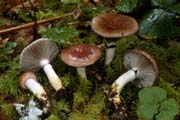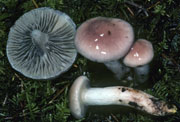
© Steve Trudell
The Gomphidius Family is easily learned, and all species are edible. Several characteristics make the Gomphidiaceae easy to recognize. The first and most obvious is the name which, like most Latin scientific names, is an attempt to describe it. Gomphidius means "little stake" or "peg" and refers to the shape of the young mushrooms with rounded caps and long, central stems that taper to a blunt tip at the bottom, very much like wooden tent stakes. The caps become convex and finally more or less depressed in age.
The second and surest feature of identification is the gills and spore print. There are very few mushroom genera which make black or blackish spore prints. Of those few, only one family, Gomphidiaceae, has gills which are decurrent, that is, the gills extend down the stem for one-half to two inches. Under the microscope the spores are mostly large and spindle-shaped. The Gomphidiaceae grow on the ground in woods in association with conifers.
For a time all species were lumped under the original genus, Gomphidius. During years of research, Dr. Orson K. Miller, Jr., professor of biology at Virginia Polytechnical Institute, determined that one section contained sufficient chemical and microscopic differences to warrant separate generic rank. This new genus is called Chroogomphus (pronounced crow-oh-gom-fus).
Fortunately visual differences are apparent to mushroom hunters who do not have the use Of a microscope.
Gomphidius and Chroogomphus species have neither volvas nor skirtlike rings, although most species have a veil when young which leaves a fragmentary ring on the stem of the mushroom as it matures.
In cross-section the gills are thick, distant, and waxy. The range of viscidity is great and helps to separate the species into smaller groups. Viscid describes mushrooms that have a layer of gelatinlike cells in the skin of the cap or stem that react like gelatin crystals. When there is much moisture available, they are slimy. After a dry spell they become dry and shiny like a varnished surface. This gluten should be wiped off before cooking the mushrooms. All species of Gomphidius are gelatinous in greater or lesser degrees, but the species of Chroogomphus are less so, some being viscid, some subviscid, some dry and fibrillose-scaly.
The species of Gomphidius, when very young, have caps with white or pale gray flesh inside, and the gills answer to the same description. Species of Chroogomphus have cap flesh and gills with yellow-buff, dull orange, or winey-red coloration.
In addition, most of the species of Gomphidius have a white column in the stem below the cap extending to a bright yellow base, while most Chroogomphus have stems in the same color series as the caps and lack the bright yellow base.
It is not necessary to tell the species apart to eat them, provided you have determined that the mushrooms have decurrent gills and leave a blackish spore print. But practice identifying the species, for safety, and just for the challenge of it.
Mention of several other species were added in the REMARKS with individual species. Gomphidius smithii is an important addition, but the others are all uncommon to rare. Gomphidius loculatus is another rare species with gill structure very interveined to loculate (chambered). The REFERENCES were also added.
Chroogomphus rutilus was changed to Chroogomphus ochraceus. O.K. Miller, who gave a description of Chroogomphus rutilus as a North American as well as European species in 1964, decided in 2003 that the North American material should be included in the concept of Chroogomphus ochraceus (Kauffman) O.K. Miller, leaving Chroogomphus rutilus (Schaeff.) O.K. Mill. as a European species. The dark mahogany cap with variants to light ochraceous apparently represent variation within one species, with both forms being found in Europe (as C. rutilus) and in North America (as C. ochraceus). The description for the revised C. ochraceus is derived from Miller & Miller (2006).
1a Cap flesh and gills white or pale, watery gray when young (Gomphidius)
................................................................................2
1b Cap flesh and gills dull yellow, salmon or winey when young (Chroogomphus)
................................................................................5
2a Lacking a veil when young
................................................................................Gomphidius maculatus
CAP 1-11 cm, glutinous, light cinnamon to reddish brown, darkening from age or handling. STEM white at apex, moist to dry, base with or without yellow ground color underneath coating of dull yellow to purplish fibrils which blacken with age or handling. SPORES in mass smoke-gray to nearly black, 14-22 x 6-9 um. HABITAT conifers, especially larch.
2b Having a veil when young, usually glutinous or gelatinous
................................................................................3
3a Cap pink, rose or red
................................................................................Gomphidius subroseus
3b Cap salmon, reddish-brown or winey-gray
................................................................................4
4a Fruiting bodies usually growing several stuck together (some may be aborted) from deep in soil
................................................................................Gomphidius oregonensis
4b Fruiting bodies usually gregarious or single, only caespitose occasionally and then lacking tuberous growth
................................................................................Gomphidius glutinosus
| Gomphidius smithii
| Gomphidius smithii © Michael Beug |
5a (1b) Fruiting body entirely yellow-orange
................................................................................6
5b Fruiting body some other color, mostly reddish-brown or winey
................................................................................7
6a Cap dry, downy fibrillose; very common
................................................................................Chroogomphus tomentosus
6b Cap viscid, bald, uncommon
................................................................................Chroogomphus ochraceus (ochraceous orange variation)
7a (5b) Cap dry, smooth to velvety; stem unusually robust and patchy-fibrillose
................................................................................Chroogomphus pseudovinicolor
7b Cap viscid, drying shiny, surface smooth young but aging fibrillose; stem average to slender in diameter
................................................................................8
8a Cap reddish-brown, often with acute umbo (knob); cystidia thin-walled
................................Chroogomphus ochraceus (reddish brown variation), for description see 6b
8b Cap dark reddish- or orange-brown to wine-colored, almost conical in shape; cystidia thick-walled
................................................................................Chroogomphus vinicolor
- END -